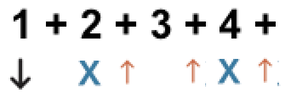MODULE 3
Strumming Techniques
In this module you will explore some of the more technical strumming patterns that will take your rhythmic sound to the next level.
CHuck Strum TECHNIQUES
This strumming technique has various names such as 'chick strum', 'chunk strum', 'muted strum', and 'palm muting', to name a few. For this course, we will stick to calling it the 'chuck strum'.
The technique behind the 'Chuck strum' makes use of the palm of your hand to collide with the strings to create a muted strum sound, which creates a percussive sound that adds a rhythmic element to the strumming pattern. If you are playing barred chords, you can simply release the pressure on your fretting hand to get a similar effect. Try practicing both ways independently.
EXAMPLE 1. This strumming pattern is known as the 'Half Chuck' and contains just one chucked beat.
The technique behind the 'Chuck strum' makes use of the palm of your hand to collide with the strings to create a muted strum sound, which creates a percussive sound that adds a rhythmic element to the strumming pattern. If you are playing barred chords, you can simply release the pressure on your fretting hand to get a similar effect. Try practicing both ways independently.
EXAMPLE 1. This strumming pattern is known as the 'Half Chuck' and contains just one chucked beat.
The 'X' that sits under beat 2 of the bar above is the symbol for a chuck strum. The strumming pattern is essentially the 'Calypso' strum with a chuck on beat 2.
EXERCISE: Try playing the half chuck technique using two bars of each of the following chords:
EXERCISE: Try playing the half chuck technique using two bars of each of the following chords:
EXAMPLE 2. This strumming pattern is known simply as the 'Chuck' strum and contains two chucked beats.
Notice how the 'X' now sits under beat 2 and 4 of the bar above. This strumming pattern is also the 'Calypso' strum but sounds great and more percussive with those chuck strums added in on the downbeats of 2 & 4.
EXERCISE: Have a go at playing the chuck technique using two bars each of same chords above but with alternative chord voicing's that require barring: (Song Crocodile Rock)
EXERCISE: Have a go at playing the chuck technique using two bars each of same chords above but with alternative chord voicing's that require barring: (Song Crocodile Rock)
NB: When you see a number on the side of a chord diagram, that represents the fret number to start at. So in the case of the 2nd position of C, you start the mini bar at fret number 3.
FLAMENCO STRUM
This is a real fun strumming technique once you get the hang of it and works well in many pop songs, as well as the Spanish hits.
The technique takes some practice and is playing using the tips of all 4 finger nails on your strumming hand. There is also a 'Fake Flamenco' method that some find a little easier which just requires a thumb strum in place of the four finger nails. All will be explained in the video below.
The Flamenco strum also contains a cheeky chuck strum on beat 3. The squiggly line that falls under beat 2 is where the flamenco strum is positioned as illustrated below:
The technique takes some practice and is playing using the tips of all 4 finger nails on your strumming hand. There is also a 'Fake Flamenco' method that some find a little easier which just requires a thumb strum in place of the four finger nails. All will be explained in the video below.
The Flamenco strum also contains a cheeky chuck strum on beat 3. The squiggly line that falls under beat 2 is where the flamenco strum is positioned as illustrated below:
EXERCISE: Have a go at playing two bars of each of the following chord for an 8-bar sequence:
DAMPENING TECHNIQUE
Dampening (or muting) refers to the technique of stopping the strings from vibrating after they have been played. This is done to prevent unwanted noise or overtones and to create a cleaner, more controlled sound.
There are different ways to dampen the strings on a ukulele. One common method is palm muting, where the player rests the palm of their picking hand on the strings near the bridge while playing. This reduces the sustain and volume of the notes and creates a percussive effect. Another technique is fret-hand muting, where the player lightly touches the strings with their fretting hand to stop them from ringing out.
Damping can also be used to create different textures and effects on the ukulele. For example, you might use a dampened strumming pattern to create a rhythmic, staccato sound, or use partial damping to create a chord with a muted or muffled tone. Overall, damping is an important technique for any ukulele player to master, as it can greatly enhance their playing and musical expression and is more technically known as vamping when playing jazz.
Dampened beats are illustrated with dotted lines underneath the directional arrows:
There are different ways to dampen the strings on a ukulele. One common method is palm muting, where the player rests the palm of their picking hand on the strings near the bridge while playing. This reduces the sustain and volume of the notes and creates a percussive effect. Another technique is fret-hand muting, where the player lightly touches the strings with their fretting hand to stop them from ringing out.
Damping can also be used to create different textures and effects on the ukulele. For example, you might use a dampened strumming pattern to create a rhythmic, staccato sound, or use partial damping to create a chord with a muted or muffled tone. Overall, damping is an important technique for any ukulele player to master, as it can greatly enhance their playing and musical expression and is more technically known as vamping when playing jazz.
Dampened beats are illustrated with dotted lines underneath the directional arrows:
EXERCISE: Try playing the first two chord with the left dampening technique and last two chords with the right side technique:
EXTENDED CALYPSO STRUM
This strumming pattern is very similar to the calypso strum but adds an extra up stroke in between beats 1 and 2.
EXERCISE: Have a go playing this pattern with the chords below and watch the video in the next section for a full breakdown.
"BLUES FILL" STRUM
This fill strum sounds really advanced when played with a half semitone slide, but will also sound great with just the initial chord. It is played over a two-bar sequence containing the first dampened strum as illustrated above and the extended calypso strum. These segments are usually played with a dominant 7th chord.
EXERCISE: Try practicing this technique with the following chords and watch the video below to see how to make this two bar pattern sound even more advanced:
Now you have some new strumming patterns to work with, now let's try mixing them up to create some fantastic rhythmic sounds:
30%



















